Hammer on Blu-ray from Indicator, part two
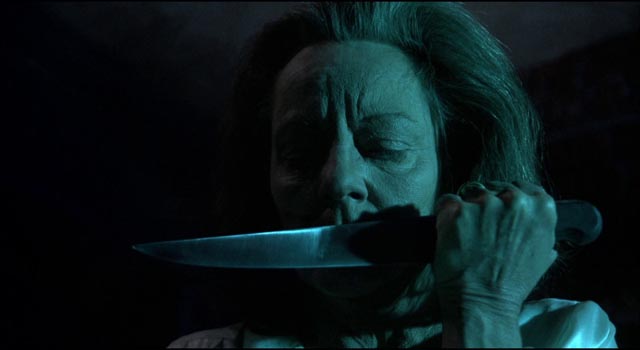
I started on Indicator’s Hammer releases with volume 2, Criminal Intent, partly because it contained one of my favourite films from the studio (Cash on Demand, 1961) and partly because it seems like the most coherent of the three box sets released so far – four black-and-white thrillers from 1958 to 1961. The other two sets are a bit more random. The third volume contains Val Guest’s two very good World War Two films, The Camp on Blood Island (1958) and Yesterday’s Enemy (1959), plus two of the studio’s most exotic horror-inflected adventure movies, Terence Fisher’s The Stranglers of Bombay (1959) and The Terror of the Tongs (1961), directed by actor Anthony Bushell. The latter two might’ve been more logically paired with John Gilling’s The Pirates of Blood River (1962) and Don Sharp’s The Devil Ship Pirates (1964).
Volume One: Fear Warning! is an even odder mixed bag, containing two of Hammer’s best films from the mid-1960s along with two of their weakest from the same period. Perhaps not surprisingly, the latter were both directed by Michael Carreras, a pedestrian talent who served the company much better as a prolific producer, while the other two were made by Terence Fisher, whose work all but defined the studio from the late ’50s on, and Silvio Narizzano, making his feature debut after years of television work in Canada and Britain.
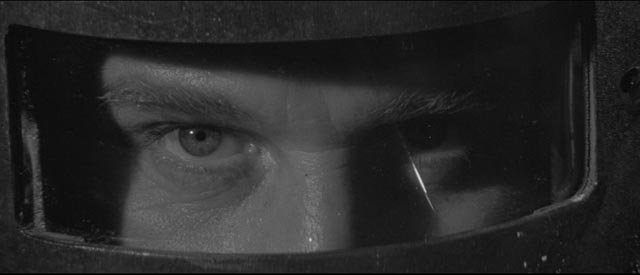
Maniac (Michael Carreras, 1963)
Maniac (1963) was the studio’s second Psycho-influenced psychological thriller, following Seth Holt’s excellent Taste of Fear (1961). Like that film, Maniac was written by Jimmy Sangster (who made a specialty of this genre) and shot in black-and-white – in this case in 2.35:1 MegaScope. The gorgeous, though at times seemingly inappropriate, widescreen imagery plus visually stunning locations in the Camargue region in southern France go a long way towards disguising the film’s problems. These begin with Sangster’s awkward script. (Although often quite entertaining, Sangster’s thrillers almost always eschew plausibility – narrative and psychological – for cheap thrills and far-fetched coincidence.) Here, he conjures up a singularly unlikable hero in Jeff Farrell (Kerwin Matthews), an American painter whom we first meet as he ditches his apparent girlfriend in a small French village. When she drives off angrily in their car, he takes a room at the local inn run by Eve Beynat (Nadia Gray).
Farrell loses no time in hitting on Eve’s teenage stepdaughter Annette (Liliane Brousse). When Eve tries to discourage him, he hits on her instead … though when she’s not around, he continues to go after the girl. He’s a boorish, egotistical jerk with no apparent impulse control, a problem only partially mitigated late in the film when we discover that Eve has been manipulating him for her own purposes. His obnoxiousness is increased by the fact that we know that Annette had been raped just four years earlier – this we see in the opening sequence as a local creep lures her to a secluded area and assaults her. (This stark, unsettling sequence is undermined by a jaunty, jazzy score by Stanley Black which works against the visual realism.) When her father is alerted, he arrives too late to stop the assault, but takes immediate revenge on the creep by tying him up and going at him with an acetylene torch. For that crime, dad is committed to an asylum for the insane.
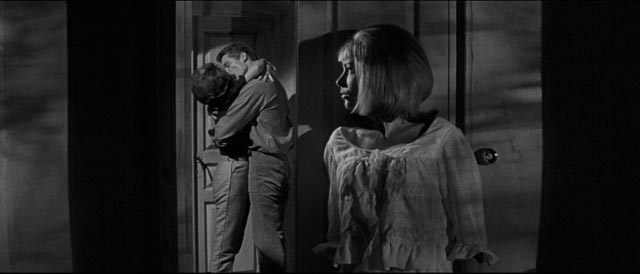
Eve convinces Farrell that she will go away with him if he can just help her break Beynat out of the institution so he can run away with Annette. Before long, Farrell is in way over his head, dealing with a dead body and finding himself the target of another acetylene torch attack. Duplicitous motives, confused identities and lingering psychological trauma lead to an impressive denouement in a vast quarry carved into a local mountain; huge chambers of white stone dwarf the characters as they stalk one another over mounds of rubble and along narrow ledges high above ground.
Carreras’ directs everything with a plodding pace which fails to instill much tension despite the wonderful qualities of Wilkie Cooper’s cinematography. The plot mechanics are clumsy and the characters poorly written, although Gray and Brousse give decent performances. But the movie’s biggest failing is Matthews, who remains stubbornly unpleasant throughout. Various comments made in the extras suggest that Sangster’s script was mainly an excuse for a paid vacation in France at the studio’s expense. It’s easy to believe that the story might have been written chiefly to make use of that spectacular quarry location … though it’s also mentioned that the end sequence was actually suggested to Carreras by one of the assistants on the crew.
As with all these Indicator disks, the visual presentation is superb and the movie is accompanied by several featurettes: a consideration of the film by Jonathan Rigby and John J. Johnson, a piece on Nadia Gray by Lindsay Anne Hallam, and brief interviews with camera assistant Ray Andrew and focus puller Trevor Wrenn.
*
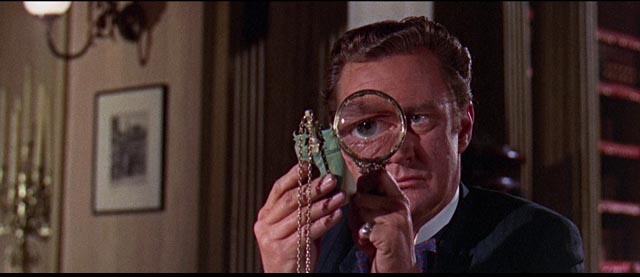
The Curse of the Mummy’s Tomb
(Michael Carreras, 1964)
The second of Carreras’ contributions here is much worse, although the commentators on the disk strive to make it sound better than it actually is. I guess I should say up front that I’m not a big fan of the Mummy as a horror character – outside of Karl Freund’s 1932 original and (here’s where I risk all credibility) Stephen Sommers’ 1999 “re-imagining”. The rather thin underlying theme of the Mummy story is one of thwarted romantic love which transcends millennia. Freund imbued his version with poetic romanticism, while Sommers went for comic adventure, both movies working well on their own terms. Despite the comedy, Sommers managed to inject some effective horror (thanks in part to the relatively new possibilities of CGI). But all the Universal sequels and the subsequent Hammer versions of the story are hampered by the fact that the Mummy is a cipher, an essentially personality-deprived, bandage-wrapped boogie which lumbers around slowly, killing characters who have to make little effort to get away, even though the Mummy is incapable of speedy pursuit. (Sommers overcame this limitation by giving him supernatural powers which are absent in other iterations.)
Carreras’ screenplay for The Curse of the Mummy’s Tomb (1964) (written under the pseudonym Henry Younger, an inside-joke nod to prolific Hammer writer-producer Anthony Hinds who signed his scripts John Elder) is a mess. Despite being made in the mid-’60s, the film is steeped in obnoxious British (and American) colonial attitudes. The members of an archaeological team funded by an American showman possess an unquestioned certainty that they have a right to ransack Egyptian tombs and take the contents away with them, irritated by the claims of the Egyptian government. This isn’t mitigated by the Englishmen’s plans to put everything into museums for the edification of the cognoscenti, which the movie tries to throw a positive light on by contrasting it with the crass commercialism of the Barnum-like Alexander King (Fred Clark), who wants to take the dead king on the road to milk the masses of their pennies.
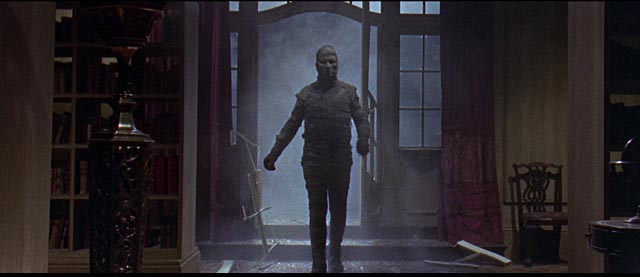
As written, there’s not a lot the cast can do with their roles, though Clark is obviously having fun hamming it up. Hero John Bray (Ronald Howard) is dull; it’s no wonder his fiancee Jeanne Roland (Annette Dubois) is so easily lured away by the wealthy Adam Beauchamp (Terence Morgan) … who, while pretty dull himself, provides the script with its one notable twist when his true identity is revealed late in the story. Commenters on the disk declare that Dubois has been unfairly maligned for her performance, but personally I couldn’t stand it – pretty much from the start it’s tonally wrong. Despite the trauma of her father being brutally killed early on by some locals who resent the Europeans digging up their ancestors, she never seems to suffer even a trace of grief, instead grinning all the time so relentlessly that she starts to seem deranged. This is compounded by the way she so quickly switches her attention to Beauchamp in front of her fiance, completely insensitive to the emotional effect she’s having on the man she supposedly loves …
The blandness (and tone-deafness) of Carreras’ direction is compounded by the flat, overlit photography which makes the film look like a TV show; there’s no atmosphere, no visual style. How can this be the work of Otto Heller, who shot such films as Robert Siodmak’s The Crimson Pirate (1952), Alexander Mackendrick’s The Ladykillers (1955), Michael Powell’s Peeping Tom (1960) and, immediately after Curse of the Mummy’s Tomb, Sidney Furie’s The Ipcress File (1965)? It’s inexplicable, other than as an indication of Carreras’ own unimaginative influence over even this aspect of the production.
The transfer is as good as you could expect, but the image just isn’t particularly engaging. There are several featurettes – on the production itself, on actress Jeanne Roland, supporting actor Michael McStay, and composer Carlo Martelli, along with a cut-down super-8 home movie version … but none of this manages to convince me that the movie is any good.
*
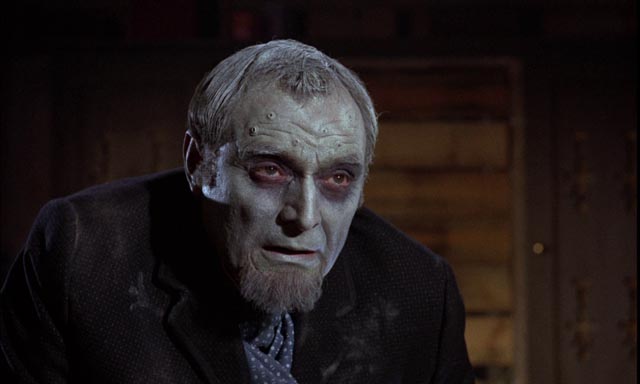
The Gorgon (Terence Fisher, 1964)
Despite one very important flaw, The Gorgon is one of Hammer’s finest Gothic movies and a high point of Terence Fisher’s career. After reworking the classic Universal monsters – Dracula, Frankenstein, the Mummy, the Wolf Man, the Phantom of the Opera – for more than half a decade, the studio decided to branch out with something original, yet also much older. John Gilling, drawing from a story by J. Llewellyn Devine, reached back to classical mythology for Hammer’s first female monster. Megaera, an immortal spirit, has somehow found her way to Germany, where she takes possession of a woman’s body at every full moon, transforming into the snake-haired Gorgon which turns anyone who looks directly at her into stone. (For some reason, the script gives her the name of one of the Furies, rather than one of the three traditional Gorgons – Stheno, Euryale and Medusa – perhaps because, with Medusa slain by Perseus, the other two had less easily pronounced names.)
Although Gilling was unhappy with changes made to his script by Anthony Hinds, the story and characters provide director Fisher with some of his richest material, a complex mix of interesting psychological conflicts with a romantic fairy tale atmosphere. The village of Villandorf lies in the shadow of the derelict Castle Borski, a shunned ruin which the fearful populace associate with a series of mysterious deaths – dismissed as “unsolved murders” by the authorities. When Bohemian artist Bruno Heitz (Jeremy Longhurst) and his pregnant girlfriend die in the woods one night, the coroner rules that Bruno killed the pregnant girl and then committed suicide. It’s a comfortable verdict which avoids any mention of the fact that both bodies had been turned to stone.
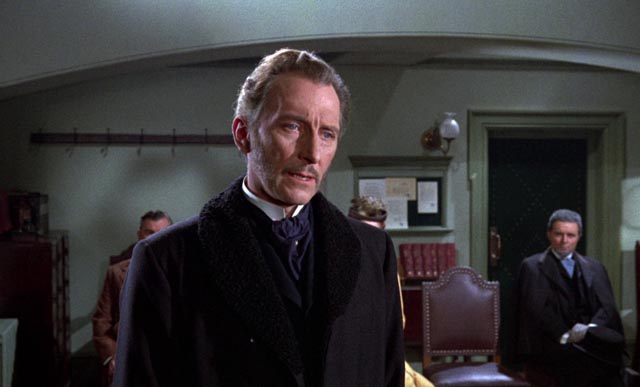
Bruno’s father Professor Jules Heitz (Michael Goodliffe), unsatisfied with the official account, arrives and begins to investige – stirring up the hostility of the locals and receiving veiled threats from Inspector Kanof (Patrick Troughton) and intransigence from Dr. Namaroff (Peter Cushing), who runs the local institution for the insane. When Heitz goes to the castle, he glimpses something horrific, but not having seen it clearly, he has time to make it back to his room in the village and write a letter to his other son as he slowly turns to stone.
Heitz’s other son Paul (Richard Pasco) arrives to continue the investigation, in the process falling for Namaroff’s assistant Carla Hoffman (Barbara Shelley) and eventually summoning his mentor, Professor Karl Meister (Christopher Lee), to help unravel the mythic explanation of what’s going on. There isn’t much mystery about the Gorgon’s identity – Carla is the only prominent female character – but that revelation isn’t the point of the story. Rather, it’s an intricate examination of tangled emotions centred on Namaroff, who tragically knows that Carla is the monster’s vessel and yet protects her (at a cost of other people’s lives) as he tries to find a way to release her from the curse she herself is unaware of.
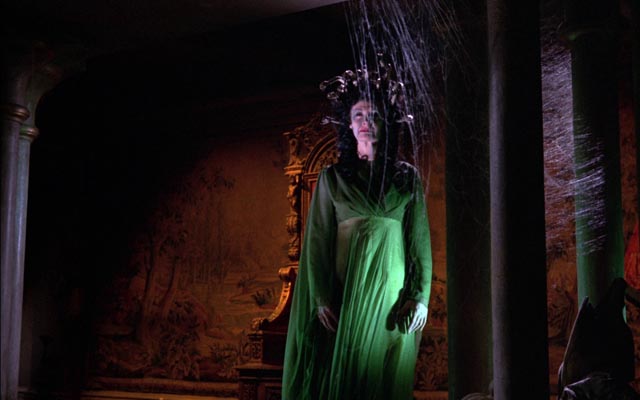
Bernard Robinson’s production design is some of the studio’s finest, with evocative sets sumptuously photographed by Michael Reed (his second job for Hammer after Don Sharp’s The Devil-Ship Pirates earlier the same year), and the cast invest their roles with conviction. Cushing’s Namaroff is one of his most interesting roles, giving him a chance to play a villain who facilitates evil as an unintentional side effect of romantic concern for Carla. Lee, given a non-villainous role for a change, injects a note of enthusiastic eccentricity (amplified close to the point of caricature by a wig and fake facial hair). Barbara Shelley is a fine tragic heroine, while Pasco avoids the usual risk of the romantic hero being a dullard. Goodliffe adds some genuine gravity as a man fighting to save his son’s reputation from the lies of the authorities, only to be destroyed by his own determination.
All of this is so good that the film’s one failing, although a major one, can’t inflict fatal damage. It’s easy to forget that Hammer films, with their strong casts and rich look, were made on very tight budgets. That limitation shows here in the inadequate realization of the Gorgon. Although Fisher keeps her in the shadows much of the time, it’s necessary for her to emerge more clearly for the climax and theatrical makeup and the stiff snakes growing out of the head undermine the dramatic impact of the final confrontation. It’s not a fatal flaw, but may explain to some degree why the film is less well-known than Hammer’s other horrors.
Indicator’s Blu-ray features a gorgeous transfar and the usual collection of supplements, beginning with a commentary from Kat Ellinger and Samm Deighan. Jonathan Rigby and John J. Johnston show up again in a short retrospective consideration of the film, while Patricia MacCormack talks about Barbara Shelley’s career and Matthew Holness offers an appreciation. Among the galleries of promotional material there’s even a comic strip adaptation from 1977.
*
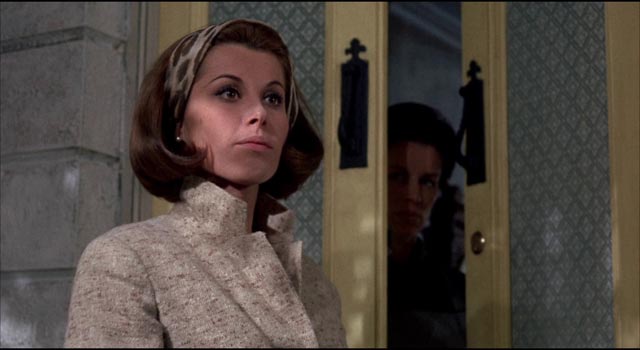
Fanatic (aka Die! Die! My Darling!)
(Silvio Narizzano, 1965)
If The Gorgon is at the pinnacle of Hammer’s famous Gothic output, Silvio Narizzano’s debut feature ranks with the best of the studio’s modern psychological thrillers. While many of these, as already mentioned, drew from Psycho and were mostly written by Jimmy Sangster, Fanatic (U.S. title Die! Die! My Darling!, 1965) drew from a different strain of Hollywood DNA, specifically Robert Aldrich’s Whatever Happened to Baby Jane? (1962), and was written by Richard Matheson (adapting a novel by Anne Blaisdell). Rooted in Grand Guignol and a fascination with the grotesque – most specifically female derangement – this sub-genre provided a late-career boost to a number of aging actresses who had been largely sidelined by an industry which was uncomfortable with older women. Bette Davis, Joan Crawford, Agnes Moorhead, Olivia De Havilland, Shelley Winters and Debbie Reynolds all appeared in movies sometimes dubbed “hag horror”.
While Davis turned up in a couple of Hammer’s contributions to the genre (The Nanny [1965], The Anniversary [1968]), the best of the studio’s forays was a showcase for 63-year old Tallulah Bankhead, who began her film career in 1918 but concentrated mostly on the stage and gained a reputation for leading a very flamboyant lifestyle of wild parties and sexual experimentation – a history which Matheson’s script explicitly draws on. In Fanatic, Bankhead is Mrs. Trefoile, a former actress turned religious fanatic who, under the influence of her late husband, has suppressed all the urges she once gave free rein to beneath a strict fundamentalist routine in her remote country house. Though she lives an austere life, forcing daily prayer sessions on her staff, we eventually discover that the cellar is a shrine to her former life and younger self, a riot of colour and glamour to which she retreats for a mixture of nostalgia and spiritual self-flagellation.
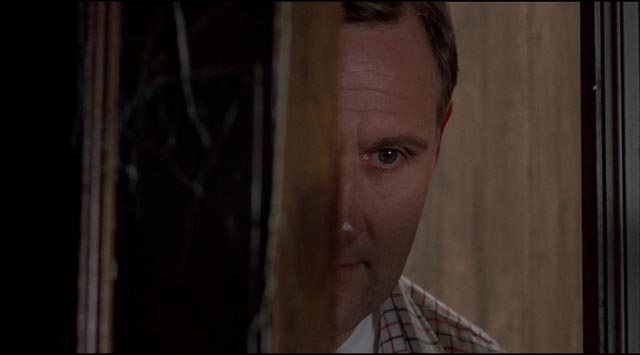
Into this claustrophobic home comes Patricia Carroll (Stephanie Powers), a young woman who had been engaged to Mrs. Trefoile’s recently deceased son. Patricia makes what she feels is a duty call only to find herself quickly trapped within the bubble the old woman has created for herself, supported by her household staff, who put up with the prayer sessions and restrictions on their behaviour because they anticipate eventual financial benefits.
Patricia is initially sympathetic and views Mrs. Trefoile with a kind of amused tolerance for her eccentricity. But before long, it becomes apparent that the old woman is determined to preserve Patricia’s “purity” so that she can be reunited with the dead son in the next life. By the time Patricia finally senses that she’s in danger, it’s too late – she’s a prisoner in the house, the old woman determined to gain her submission even if it means starving her to death to “save” her.
Housekeeper Anna (Yootha Joyce) is conflicted about helping to keep Patricia prisoner, but feels herself trapped between Mrs. Trefoile and her own husband, Harry (Peter Vaughan), a brute given to drinking who sees Patricia as ripe for sexual exploitation. With Patricia’s barely glimpsed new fiance Alan (Maurice Kaufmann), Vaughan’s crude Harry and the simple-minded gardener Joseph (Donald Sutherland) as the only men in the story, the three women dominate the narrative, each displaying a complicated mix of strengths and weaknesses as they play a potentially deadly game of dominance and submission.
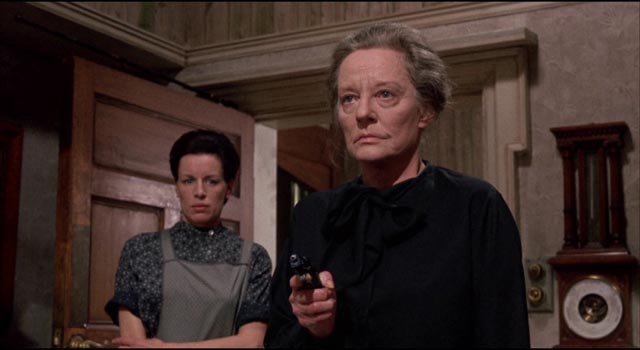
While the involvement of Matheson, Bankhead and Powers represented an attempt to appeal more directly to an American audience, the film benefits strongly from their presence. Matheson’s script is more tightly constructed than Sangster’s often gimmicky stories and the characters are given psychological depths which amplify both suspense and audience involvement. Bankhead, Powers and Joyce seize every opportunity to breathe life (and often subtle humour) into their roles. Joyce in particular, in the less showy part, has some genuinely moving moments as she struggles with inner conflicts, trapped herself yet aware of the moral horror she’s involved in.
In The Gorgon, for the first time Hammer presented a female monster, but she remains the Other, an outside force which disrupts and destroys men. Just a year later, Fanatic is entirely female-centric; yes, the monster is female, but the world in which events occur is entirely defined by her influence, and the impact of that influence is effected on the other women who enter her orbit — the compromised and conscience-stricken Anna and Patricia who is initially victimized because of her decency, but eventually discovers her own inner strength to fight back — while the men remain peripheral and ineffectual figures.
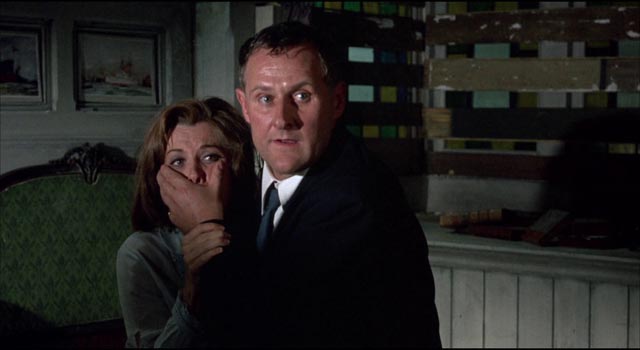
Narizzano, ably supported by his cast, production designer Peter Proud and veteran cinematographer Arthur Ibbetson (working on his only project for Hammer), creates a dense hothouse atmosphere of suppressed and twisted emotions. Fanatic works as psychological suspense, black comedy and plausible horror, faltering only slightly in the climactic scenes with their explosion of violence in that cellar shrine, where we descend into the distorted mind of Mrs. Trefoile which can only find release from its intolerable inner tensions between repression and desire in an attempt to destroy the more balanced sexuality of Patricia, whom she perceives as a rival for her adored son’s affection. These scenes feel rushed and perhaps a sop to the expectations of an audience seeking conventional horror rather than intricate character-based drama.
Apart from this slight weakness, the film’s only other flaw is the score by Wilfred Josephs, who too often emphasizes the otherwise subtle humour rather than the suspense.
Needless to say, the transfer looks wonderful, with imagery moving from naturalistic towards increasingly subjective uses of colour as the levels of madness increase, finally reaching a Bava-esque riot of colours in the cellar finale. The usual suspects offer their thoughts in a retrospective featurette; Kat Ellinger provides a sketch of Bankhead’s colourful life; continuity supervisor Renée Glynne and second assistant director Stuart Black reminisce about their work on the film; David Huckvale talks about the career of composer Wilfred Josephs; and playwright Matthew Lombardo talks about Bankhead and his play Looped, which was based on an incident from the film’s post-production. The film can be watched with either the British or the U.S. titles, but otherwise the two versions are identical.
Comments